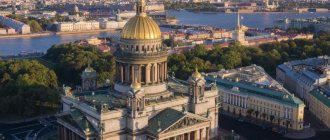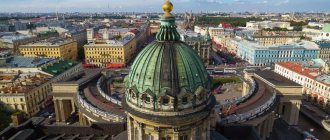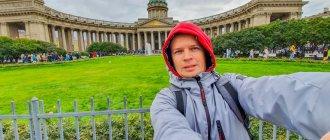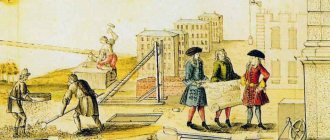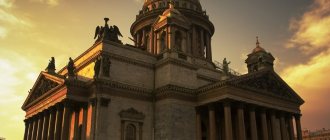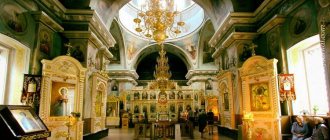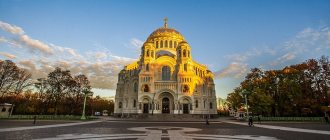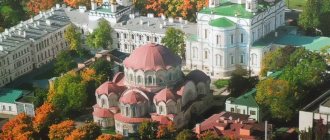| Saint Petersburg. Peter and Paul Cathedral. |
St. Petersburg Cathedral in the name of the Supreme Apostles Peter and Paul
of the St. Petersburg Diocese
- Throne: app. Peter and Paul
- Address: Russia, St. Petersburg, Peter and Paul Fortress
- On the map: Yandex.Map, Google map
The cathedral was founded almost simultaneously with the Peter and Paul Fortress on Hare Island on the day of the Holy Chief Apostles on June 29, 1703 and became the first church in St. Petersburg.
According to legend, Peter I himself determined the location for the future temple, placing crisscrossed pieces of turf in the center of the fortress. In 1712, on the site of a wooden church, according to the design of the architect Domenico Trezzini, construction began on a new stone Peter and Paul Cathedral. Upon completion of construction work in 1733, on the feast of Peter and Paul, a solemn ceremony of its consecration took place. Until 1859, the cathedral was a cathedral, and its three-tier bell tower (height 122.5 m), topped with a gilded spire with the figure of a flying angel, rightfully became one of the symbols of the city.
The Peter and Paul Cathedral is also the tomb of all Russian Tsars, starting with Peter I and ending with Alexander III.
The staff consisted of a rector with the rank of archpriest, clergy - priests and deacons, clergymen (sacristans and sextons; from the 1860s - psalm-readers), bell ringers (they often simultaneously performed the functions of stokers and watchmen), and a malt [1].
In 1919, the Peter and Paul Cathedral was closed, and in 1924 it was turned into a museum.
In 1996, a rector was again appointed for the cathedral. In 1999, after a long break, the tradition of holding services on the patronal feast day of the church was restored in the cathedral. At the beginning of 2008, regular services were resumed on Sundays, twelfth holidays, patronal feast days, as well as on special memorial days: days of remembrance of Sovereigns and Grand Dukes [2].
Strategic and spiritual outpost of the Baltic
To feel the greatness of the moment, let’s plunge into the thick of events dating back to 1703. Wanting to consolidate the success achieved by the Swedish military company (the war lasted until 1721), the Tsar decides to build the Peter and Paul Fortress on Hare Island, establishing here reliable protection for enemy attempts to return territories over which control was lost. Everything about the fortress project was innovative and “hitherto” unknown to the world. First of all, a bridge, unique at that time, is brought from the mainland to the island and a water canal is built to provide the military contingent and construction workers with drinking water.
At the same time, famous architects from France and Italy, invited at the state level, are working on the project of the Peter and Paul Cathedral - a religious complex, which, according to the emperor’s plan, “will open a window to Europe” and serve as proof of the greatness of his State. Therefore, only advanced positions that are capable of surprising and striking, demonstrating power, military and technical development, intelligence and prosperity are taken into account.
Already in 1704, the pre-built wooden church was illuminated. From the height of its bell tower a military patrol was constantly conducted, and on holidays military and domestic banners were hoisted on the site. In May 1712, a celebration took place where the authority of Tsar Domenico Trezzini was entrusted with laying the first stone in the foundation of the Peter and Paul Cathedral. As planned, its stone walls began to be erected around the existing wooden church, which was later dismantled and moved to a new location.
Peter and Paul Cathedral
Peter and Paul Cathedral
The Peter and Paul Cathedral is the oldest church in St. Petersburg. It began to be built on July 12, 1703, the day of the Holy Apostles Peter and Paul, on the territory of the newly founded fortress. The consecration of the first wooden Peter and Paul Church took place on April 1, 1704 [2, p. 20]. On May 14, a festive service was held here in honor of the victory of Field Marshal B.P. Sheremetyev by Swedish ships on Lake Peipsi.
The outside walls of the church were painted yellow marble. The temple was crowned with a spire. Its first graphic image dates back to 1705 (engraving by F.N. Nikitin). The first description appeared in 1710:
“In the middle of the fortress, close to this canal, stands a small but beautiful wooden Russian church with one elegant pointed tower in the Dutch style. At the top of the tower hang several bells, which, touched by the hand of man, each hour perform as a prelude a harmonious bell ringing in the Dutch manner, and on which man, in the absence of a clock mechanism, manually strikes a certain bell in accordance with the number of hours, indicates the time" [Cit. from: 2, p. 20, 21].
On June 8, 1712, Domenico Trezzini founded a new large stone church. Construction began only in May 1714. The walls of the temple began to be erected right around the old wooden church, which in 1719 was dismantled and moved to Gorodovoy Island, placing it on a stone foundation. There it was called the Temple of the Apostle Matthew. Later, this church was also rebuilt in stone and stood until the Great Patriotic War.
First of all, several hundred people dug deep ditches and laid the foundation. The Peter and Paul Cathedral was placed on a strip foundation two meters deep, which is unusual, since foundations on piles were used much more often then. The stone walls of the Peter and Paul Cathedral began to be built from the bell tower, as Peter I ordered. It was necessary at that time as an observation deck from where one could see the approach of the Swedish troops. On January 24, 1715, Peter I demanded that “ the bell tower, which is in the city, be finished as soon as possible, so that in the future 716 it would be possible to put a clock on it, and gradually build a church
«.
While traveling around Europe, Peter I drew attention to the chimes that were on some European churches. Peter wanted to have the same ones in Russia; three chimes were purchased, one of which was delivered to St. Petersburg. The tsar’s desire to see the clock in action was so great that, under his pressure, chimes were installed on the unfinished bell tower.
The creation of the spire of the Peter and Paul Cathedral began in the winter months of 1717, when the preparation of rafters began. On May 1, Domenico Trezzini invited the Dutchman Herman van Boles to work on this complex engineering structure, who created a project for a 25-meter spire and spent several years implementing it. In September 1718, an apple was lifted onto the spire. In May 1719, the Office of City Affairs entered into an agreement with the Riga master F. Zimers, according to which he forged 887 sheets of red copper. In April 1721, an agreement was signed with the Riga masters I. P. Steinbeis and I. V. Eberhard for the gilding of these sheets.
Already under Peter I, the Peter and Paul Cathedral became a tomb for members of the royal family. In 1715, the wife of Tsarevich Alexei Sophia-Charlotte-Christina was buried here, in 1717 - the sister of Peter I Maria Alekseevna, in 1718 - Tsarevich Alexei.
In August 1720, the clock began to play in the bell tower. Peter I climbed it several times. He gladly invited foreign guests there, including the Holstein chamber-junker Bergholz. In his diary he wrote:
“On 7 [August 1721] a large company of those who remained at home climbed the fortress tower at noon, partly to look at the chimes, because at that hour the bells were supposed to be played, partly to see the whole of St. Petersburg, because it is the tallest tower in the city... The large clock mechanism plays independently every quarter and half hour. When we climbed to the very top of the tower to the bells, the “bell player” gave us a large telescope through which we could see Peterhof, Kronshlot and Oranienbaum. St. Petersburg itself has an oval shape and an unusually large length, but in many places it is only sparsely built up, but if the Tsar lives for some time, it will be completely built up" [Cit. from: 2, p. 101, 102].
Entry from the same diary for 1721:
“The fortress church, as I have already mentioned, is the most beautiful and largest in all of St. Petersburg and has a very high and beautiful new-fashioned bell tower, covered with copper sheets brightly gilded through fire, which in sunlight make an unusually beautiful impression; but the inside of this church has not yet been completely rebuilt. The chimes of this church are very large and beautiful, just like those in Amsterdam, and they say they cost 55,000 rubles. They are played every morning from 11 to 12 o’clock, in addition, every half hour and hour they also play by themselves, driven by a large iron machine with a copper shaft...”
Climbing to a height of 60 meters has always been difficult. To simplify this procedure, Peter I decided to build an elevator in the bell tower, which was a real miracle at that time. During a visit to Dresden in 1711, Peter I met the court mechanic of the Saxon Elector Andreas Gärtner, who in his house demonstrated to the Tsar a lift on which he rose from floor to floor. The documents preserve information that on September 17, 1720, cloth for a lifting chair was purchased from Gostiny Dvor. That is, an elevator in the bell tower of the Peter and Paul Cathedral could really have been created. But for unknown reasons it was either dismantled very quickly or was never launched at all [2, p. 102, 103].
Back in May 1722, Domenico Trezzini proposed installing an angel at the top of the bell tower. The architect made a drawing, according to which the figure was made by the peasant I. Menshoi and the silversmith L. Zadubsky. But their work was found to be of poor quality, so the angel was remade by Steinbes and Eberhard. That angel was different from the one that exists today. It was made in the form of a weather vane; the figure of an angel was held with both hands by the axis, in which the turning mechanisms were placed.
The gilding of the copper sheets was completed by November 1723. Work on covering the spire with gilded sheets and installing an angel was completed in 1724. The height of the bell tower from the foundation to the top of the cross was 106 meters.
The Peter and Paul Cathedral was built according to completely new principles for Russia at that time. Its architectural design was influenced by Western traditions. The walls are much less thick than those of traditional Russian churches, large windows, high narrow pillars (pylons), only one dome (instead of the usual five-domed structure). This cathedral became an example for all other churches until the middle of the 18th century. Further, by decree of the Synod, churches again began to be built with five domes.
The painting inside the Peter and Paul Cathedral is important from the point of view of the development of Russian art. Before this, the walls of temples were painted completely differently; only biblical scenes were allowed to be reproduced. Secular artistic ornaments are also used here. The painting of the temple walls belongs to Russian artists Vorobyov and Negrubov. The lampshades in the central nave were made by Pyotr Zybin.
Hall of the Peter and Paul Cathedral
After the death of Peter I in 1725, the coffin with his embalmed body stood for 6 years among the walls of the unfinished cathedral. Later, a coffin with the body of his wife Catherine was placed nearby. In 1731, upon completion of the construction of the temple, Peter I and Catherine were buried near the southern wall in front of the altar. Initially, there were only marble slabs at the burial site, without tombstones. Tombstones appeared here in the 1760s. Almost all of them are the same, made of white marble slabs. The tombstones of crowned heads have coats of arms at the corners. Two tombstones are unique; the burials of Alexander II and his wife Maria Alexandrovna are made of jasper and orlets. They are monolithic, each weighing about 5-6 tons.
The iconostasis of the Peter and Paul Cathedral is unique. It has the shape of a triumphal arch - a symbol of Russia's victory in the Northern War. Made in Moscow in 1722-1726 in the workshop of Ivan Zarudny from oak and linden. The original drawing of the iconostasis belongs to Domenico Trezzini. It was reproduced by more than 50 workers under the leadership of Ivan Zarudny himself. Small details were specified during production, so the authorship of the iconostasis is attributed to both architects. It was brought from Moscow in 1727 disassembled, assembled in the cathedral itself and covered with gold here. For another two years, icons were created, which were painted by Andrei Merkulyev “and his comrades.” Some of these icons have survived to this day; their shapes are unusual. In the center of the iconostasis of the Peter and Paul Cathedral are the royal doors with sculptures of the apostles.
In 1732, Nicholas Proskop installed a pulpit on the left side of the central aisle. It is made of carved gilded wood. At the bottom of the pulpit there are paintings depicting the parable of the sower. Above are the figures of the apostles Peter and Paul, above them are the four evangelists. At the very top of the pulpit there is a figure of a dove, symbolizing the holy spirit.
On the right side of the central aisle is the royal seat. It is also made of gilded carved wood and covered with velvet. There was never a chair here; the king did not sit down during services.
The central nave is illuminated by crystal chandeliers from the late 18th century. Closer to the altar is the original, others were restored after the Great Patriotic War.
Captured banners and keys to cities and fortresses taken in the wars with Sweden and Turkey were kept in the Peter and Paul Cathedral. Now the original flags are in museums, and their copies are placed on the walls.
The consecration of the completed Peter and Paul Cathedral took place on June 29, 1733. It acquired the status of a cathedral and remained so until the opening of the new St. Isaac's Cathedral in 1858. It became the largest building in St. Petersburg. The walls of the temple were painted blue, the pilasters and cornice were painted white, the roof, bell tower domes and altar dome were painted dark blue.
Iconostasis of the Peter and Paul Cathedral
In this form, the Peter and Paul Cathedral stood until 1756. On the night of April 29-30, 1756, the spire was struck by lightning and fell burning onto the roof of the cathedral. The bell tower was then completely lost, the roof was damaged, the portico at the entrance was broken, and the chimes' bells melted in the fire. The iconostasis was saved during the fire. Its collapsible design contributed to this; Prince Golitsin’s soldiers carried it out of the building piece by piece.
Already on April 31, a decree was issued on the speedy restoration of the Peter and Paul Cathedral. Builders were urgently gathered from all construction sites and quickly restored the roof of the cathedral. Initially, the roof of the cathedral was gable, but after restoration it becomes flatter. The bell tower took 20 years to restore. It was decided to build it not from wood, but from stone. Due to the increased mass of the structure, piles began to be driven into the base of the bell tower. An additional wall appeared, resulting in additional rooms. Thus, in the Peter and Paul Cathedral there arose the Catherine's vestibule, a sacristy, and a separate space for the staircase to the bell tower. At the same time, volutes appeared on the second tier of the bell tower, the height of the spire was increased to 112 meters, and the shape of the dome drum was changed.
Under Peter III, no funds were allocated for the restoration of the Peter and Paul Cathedral; under Catherine II, a special architectural competition was organized. Projects by Felten and Chevakinsky were submitted to the competition, which envisaged radically changing the image of the temple. However, at the insistence of Catherine II, they began to restore it according to the original design of Domenico Trezzini. The new wooden structure of the spire was made according to Brouwer's design. It was erected by a team of talented engineer Eremeev. This engineer was noticed to be addicted to drinking, so they issued a special order not to let Eremeev leave the fortress without supervision. The new spire grew from 112 meters to 117. The angel was made according to the original drawing.
The new chimes were asked to be made by the Russian watchmaker Miller. He agreed to do the work, but refused to sign the necessary guarantees. Then a competition was announced and the Dutch master Oort-Kras won. An agreement was concluded with him, according to which he received the first part of the fee when presenting the mechanism of the clock to the commission, and the second only after installing the chimes on the bell tower of the cathedral. In the fall of 1760, the watch was brought to St. Petersburg. Oort-Krass is paid the first part of his salary, but it is not possible to install them on the bell tower, since it actually did not exist yet. The mechanism had to be temporarily placed on a small temporary bell tower. While waiting for the completion of the new bell tower in 1764, Oort-Kras dies. Chimes were installed on the bell tower of the Peter and Paul Cathedral only in the late 1770s.
Burials of Alexander II and Maria Alexandrovna
The second angel of the spire of the Peter and Paul Cathedral died during the hurricane of 1778. A strong wind broke the figure and the turning mechanism was damaged. The third angel was designed by Antonio Rinaldi. He combined the center of gravity of the angel and the cross, now the figure did not “fly” holding the cross with both hands, but seemed to be sitting on it. In addition, the angel ceased to function as a weather vane. It continued to rotate under the influence of the wind, but much more effort had to be applied to do this. Rotation of the figure was now necessary only to reduce its windage.
At the end of the 1820s, a strong gust of wind tore off the wing of the angel on the spire, which almost fell on the commandant of the fortress, General A. Sukin. Correcting the damage required the construction of scaffolding around the bell tower, which required large financial and time expenditures. But a young roofer from the Yaroslavl province, Pyotr Telushkin, offered his services to the city authorities. He volunteered to climb the bell tower spire without scaffolding and repair the angel. The roofer estimated the purchase of materials needed for repairs at 1,500 rubles, and left the amount of the reward for his work up to the customer’s conscience.
Telushkin's proposal was discussed for a year and a half. In October 1830, the roofer performed a job that was watched by a crowd of curious people at the walls of the Peter and Paul Cathedral. Telushkin's only equipment was ropes with loops at the ends and a movable knot. Repairing the angel took him six weeks. For his work, the roofer received an award of 3,000 rubles and a silver medal “For Diligence” on the Anninskaya Ribbon.
In the middle of the 19th century, there was a need to restore the spire of the Peter and Paul Cathedral. Engineer Zhuravsky won the organized competition. The new spire was created in 1857-1858 in the Urals, at the Nivyansky plant. The spire is made of a metal frame covered with gilded copper sheets. Its height was 47 meters, weight - 56 tons. Inside there is a staircase at 2/3 of the height, then there is an exit to the outside; brackets lead to the end of the spire. The total height of the spire with the cross and the figure of an angel was 122.5 meters. This is still the tallest architectural structure in St. Petersburg. The design is designed for vibrations in the horizontal plane up to 90 centimeters. The figure of the angel was replaced, the figure slightly changed its appearance, and it is in the form created then that the angel can be seen to this day. When the spire structures are replaced, the chimes are also reconstructed. A minute hand is added to the clock, the chimes are reconfigured to play two melodies (“How Glorious is Our Lord” and “God Save the Tsar”).
Burial place of the family of Nicholas II
In the 19th century, a marble base was placed under the iconostasis to avoid the influence of dampness; the wooden gates were replaced due to dilapidation, and new ones were made of bronze.
When there was no room left for burials in the Peter and Paul Cathedral, a tomb was built next to the temple by 1908 (designed by D.I. Grimm and L.N. Benois), and the buildings were connected by a corridor. In 1904-1906, a fence was installed in front of the western entrance, modeled on the fence of the Summer Garden. It was decided to bury only members of the imperial family, not the crowned heads themselves, in the tomb. Before the start of the First World War, they managed to move 8 burials from the right nave of the cathedral. In addition, 5 more great princes were buried here. In total, there were 30 crypts in the tomb.
Theater artist M. A. Grigoriev recalled at the beginning of the twentieth century:
“In the cathedral, the walls and pylons were hung with silver and gold wreaths, which various organizations and institutions sent to the royal tombs. Some of the wreaths were strewn with jewels. At the tombs there were flowers, wreaths with memorial ribbons lay, countless lamps were burning, many of which were genuine works of art. There were silver candlesticks with lit candles. The swords of the kings lay on the tombs, and banners were placed at the corners of the gratings surrounding the graves. The cathedral made a gloomy but very majestic impression. Rays of light, breaking through the windows, lit up thousands of reflections on silver and gold and competed with the lights of lamps and candles.” [Cit. from: 4, p. 119]
After the revolution of 1917, the Peter and Paul Cathedral was recognized as an architectural monument; its decoration was preserved. After the temple was closed in 1919, the valuables were removed from it, and the building was given to the City History Museum. War trophies were transferred to the Hermitage and other museums.
The Grand Ducal tomb was plundered, marble tombstones were broken. For a long time there was a warehouse there.
In the 1930s, on the initiative of workers, the question of replacing the angel of the bell tower spire with a ruby star was considered. They managed to draw up documents for this project, but due to the outbreak of the Great Patriotic War, this work was never completed. During the siege of Leningrad, the spire of the Peter and Paul Cathedral was painted over, and the angel was covered with burlap.
In 1992, Vladimir Kirillovich, a member of the Romanov dynasty, was buried in the restored grand ducal tomb. The next burial in the Peter and Paul Cathedral took place in 1998, when the remains of Nicholas II and his family were transferred to the Catherine's Precinct. The last to be buried here was the wife of Emperor Alexander III. Her remains were brought here from Denmark.
Share
Rate this article
Rating 77%
Sources
1 Ovsyannikov Yu. M
.: “Great architects of St. Petersburg. Trezzini. Rastrelli. Russia". Publishing house "Art-SPb", 2001 - 632 pages.
2 Malinovsky K.V.
: “St. Petersburg of the 18th century.” Publishing house "Kriga", 2008 - 576 pages.
3 Zhigalo M. V., Tukianen I. A.
: “The most famous churches of St. Petersburg.” Publishing house "Olympus: Astrel: AST", 2007 - 285 pp.
4 Grigoriev M. A.
: “Petersburg at the beginning of the twentieth century // Nevsky Archive. - 2001. - Issue. V. - pp. 101-137." Publishing house "", - p.
"Baroque Petra"
Construction of the Peter and Paul Cathedral lasted 20 years. Work was carried out until 1732. The style of its architecture, although it gravitated toward Italian and French classicism, did not have a clear direction and was called “the pearl or baroque of Peter.” (Literally, “baroque” is translated as “a pearl with a flaw”). It differed from the “Naryshkin Baroque”, in the style of which Moscow and other Russian cities were built, close to the Byzantine style, in its novelty and extravagance and reflected the remarkable talent of Domenico Trezzini, the first architect of St. Petersburg and the author of sketches of the famous Angel on the spire.
Grand Duke's tomb in the Peter and Paul Cathedral
The structure was erected at the turn of the 19th and 20th centuries; it was planned to bury uncrowned representatives of the imperial family in it. The building is connected to the cathedral through a covered passage. The facades of the tomb are decorated with mosaic icons. A significant part of the interior decoration elements have not survived to this day. After restoration work, the tomb was opened to visitors.
© Konstantin
A new approach to cathedral construction technology
The foundation of the Peter and Paul Cathedral began with a violation of the traditional order of construction of churches. The first step was to raise the bell tower, which was important for the city as a strategic object. The Northern War was in full swing and the presence of a high-altitude observation deck with well-aimed archers to monitor the movement of Swedish ships through the waters was of the greatest importance for the security of the new St. Petersburg.
The foundation stone for the cathedral building was also carried out in a way unique for that time. The builders did not drive piles into the swampy soil; they dug voluminous ditches 2 meters deep, in which they later built a strong strip foundation. This approach required more effort, but promised an excellent result in the strength and durability of the building.
Temple decoration
author: Irina Irina
The interior of the cathedral resembles the ceremonial hall of a palace. The paintings on the walls were created by famous artists A. Matveev, G. Gzel and others. The carved iconostasis is made in the form of a triumphal arch (design by I. Zarudny), and the icons are by the Moscow master A. Pospelov.
author: Dmitry Kazakov
author: Dmitry Kazakov
Opposite the altar is a magnificent gilded pulpit, decorated with statues of the two Apostles. The royal seat is decorated with a carved gilded crown and crimson velvet.
author: Dmitry Kazakov
The cathedral became a monument to Russian military glory. War trophies of the Russian army were kept here.
author: Dmitry Kazakov
In the spirit of new times
The construction of the Peter and Paul Bell Tower lasted 8 years. All this time, services were held in a wooden church. The uniqueness of the structure was manifested not only in its enormous height, but also in its special symbolism, asserting royal power in the Baltic, as well as in its form with features inherent in European secular buildings.
Made in 3 tiers, it seems to rush upward, crashing into the heavens with a tall twenty-five meter spire, sparkling with gilding. And at the top, a huge figure of a Guardian Angel, more than 3 meters high, spread huge wings, 3.8 meters wide.
Traveling around Europe, the tsar was shocked by the clock with chimes that he saw on the walls of a Dutch church. The innovative spirit did not allow him to remain indifferent. Without haggling, he ordered 3 copies of similar mechanisms. In 1720, in St. Petersburg, the chimes began to chime the time. The amazing striking clock was delivered to Russia and installed on the bell tower, where the frame of the 25-meter-high spire still had to be gilded. The watch was very important to Peter. He gave them symbolic meaning, bringing the country out of humiliating desolation to the European level.
Commandant's Cemetery
Near the Grand Ducal Tomb and behind the Peter and Paul Cathedral there is the Commandant's Cemetery - one of the oldest cemeteries in St. Petersburg.
The cemetery contains the ashes of the commandants of the Peter and Paul Fortress who died at their post.
The first funeral ceremony at the cemetery took place in 1720 in the presence of Peter I - the funeral of the tsar’s close associate, Lieutenant General of the Russian Army R.V. Bruce.
The last burial took place in 1914 - General of the Infantry, Adjutant General V.N. Danilova.
The cemetery was damaged during the Great Patriotic War. In the 1960-1980s, archaeological excavations were carried out on its territory and damaged tombstones of 18th century commandants were restored.
The entire territory of the cemetery is planned in three levels, corresponding to the chronology of burials: tombstones from the 18th century are located in the center on the lowest level; burials from the 19th century are on the middle level in the southern part of the cemetery; 20th century graves are at the modern level, in the northwestern part of the cemetery.
In total, there are 19 graves located on the territory of the cemetery.
Majestic solemnity and regal originality
The height of the building of the Peter and Paul Cathedral is 16 meters. The base of the building is arranged in the shape of a rectangle, the thickness of the stone walls is much thinner than in other Orthodox churches in the country. Special attention is paid to the tall windows, flooding the room with daylight, and the unique candlesticks and lamps created by Peter Zybin. The arch of a single huge dome is supported by narrow but powerful pylons lined up in a row.
The most innovative ideas were used in the surroundings of the cathedral. Not only scenes from biblical life are used in the wall paintings, but also pictures of the heroic history of the kingdom are harmoniously interwoven.
The gilded carved iconostasis of the cathedral emphasizes Peter's victory in the war and is made in the shape of a triumphal arch. It was presented to the cathedral as a gift from the royal couple. The carving and installation was entrusted to the skilled carvers of Ivan Zarudny’s workshop.
The program for the iconostasis was drawn up by Peter I, together with Archbishop Feofan Prokopovich. The composition contains 5 large icon cases, on which 43 holy icons are installed, painted by masters A. Protopopov and F. Pospelov. Linden and oak icons were painted in Moscow based on sketches from the St. Petersburg drawing school. The sketch of the altarpiece stained glass window “The Resurrection of Christ” was prepared by the artist N. Bruni.
Let's celebrate! The decoration of the Church of Peter and Paul in St. Petersburg is unique. Today, dozens of scientific papers and research papers are devoted to each of its elements.
Architectural features
The cathedral does not resemble the typical Orthodox churches of pre-Petrine Russia. The building measures 61 m by 27.5 m and stretches from west to east. Its dome is crowned by a narrow spire 122.5 m high. For three hundred years, the main temple of the fortress was the tallest building in the city and emphasized the role of kings in governing the great country.
View of the Peter and Paul Cathedral from Cathedral Square of the Peter and Paul Fortress
The façade of the cathedral is decorated in a strict European style. There is no excess of gold and bright colors typical of old Russian churches. The decor is very modest. The temple is decorated only with flat pilaster columns and cherub heads on the windows. Despite the severity, the church looks light and upward-looking.
In the eastern part of the building you can see a fresco by the artist Titov, which depicts the apostles Peter and Paul standing in front of Jesus Christ. In the west, on the side of the bell tower, the facade in two tiers is decorated with pilasters. The third tier is completed by an expressive eight-pitched roof, and above it stands an octagonal drum.
At the very top there is a golden crown, and a narrow spire rises to a height of 40 m. The bell tower building is a noticeable landmark in the city; it can be seen from different areas of St. Petersburg.
Preaching pulpit and monument to military valor
Previously, sermons were not read in Orthodox churches. In the Peter and Paul Cathedral, during the reign of Peter, this rule was changed. Why was the pulpit placed next to the altar? A platform was erected symmetrically to it, called the royal place, where the emperor stood at divine services, against the backdrop of trophy banners, keys to cities conquered from the enemy, and other exhibits demonstrating the military might and heroism of the fatherland, displayed for everyone to see. Today, the original relics are in the Hermitage, and their copies are presented in the temple.
St. Petersburg Diocese
From the beginning of 1742, the main cathedral of St. Petersburg became a cathedral. Regardless of the fact that in the 19th century. The metropolitan's chair was transferred to St. Isaac's Cathedral; the status of the Cathedral of Peter and Paul was not deprived.
Useful information for visitors
The temple and tomb are open on weekdays from 10:00 to 19:00, on Saturday from 10:00 to 17:45, and on Sunday from 11:00 to 17:45. A ticket for adults costs 450 rubles, for students - 250 rubles, and for pensioners - 200 rubles.
Interior of the Peter and Paul Cathedral
In the cathedral you can see the burials of the kings, beautiful stucco moldings, military relics and paintings. The guides talk interestingly about the role of the imperial family in the history of Russia.
Burial vault for the Romanov imperial family
Next to the temple building, the design of the Peter and Paul Cathedral included the construction of the Grand Ducal Tomb - a burial place for persons of the imperial house. Currently it has 54 burials. Both buildings were united by a gallery, illuminated by high windows and many lamps.
In the last years of the last century, the following were buried here: the great-grandson of Tsar Alexander II - Grand Duke Vladimir Kirillovich (1992); the ashes of his father and mother were transferred from the Cobourg cemetery (1995).
Abbots, clerics
- John Yakovlev
- Georgiy
- Anastasius Kondoidi (? - 1721)
- Pyotr Grigoriev (1721 - 1736)
- Mikhail Slonsky (1736 - May 16, 1754)
- Alexey Frolov (1740s)
- Pyotr Grebnevsky (1740s -1754)
- Pyotr Gus (1757 - 1762)
- Stefan Levitsky (1762 - January 27, 1763)
- Sergius Nikitin (1763 - mentioned July 11, 1764 [4])
- Alexander Mikhailov (1764 - April 6, 1769)
- Sergius Konoplev (1779 - January 20, 1800)
- Pyotr Vinogradov (1800s)
- Grigory Dobrotvorsky (? - 1855)
- Alexander Blagoveshchensky (1855 - 1856)
- Dmitry Florinsky (mentioned 1867 - 1888)
- Ioann Nechaev (mentioned July 29, 1892)
- Sergius Preobrazhensky (? - 1895)
- Alexander Dernov (1897 - June 1, 1899)
- Konstantin Veltistov (1901 - 1916)
- 1922 — 1996
The influence of historical changes and trends of the times
Over time, lightning destroyed the majestic spiers, groundwater undermined the bases of the columns, and premises needed for housekeeping were added to the Peter and Paul Cathedral. Restorations left their mark on the spire and on the figure of the Angel. Thanks to changes in political power and wars, the very purpose of the Peter and Paul Fortress changed, turning from a formidable and warlike outpost that made the sovereign’s ill-wishers tremble, into a cultural center and spiritual heart of the city of St. Petersburg.
The Peter and Paul Fortress and the Cathedral, like the city, have gone through different times. For some time it was an ominous prison, later – a museum of the revolution, a warehouse.
Fortunately, today it is a wonderful temple complex, perfectly restored. It is hospitable and beautiful in its beauty and serves people in the name of the first and supreme apostles Peter and Paul and the great Russian State.
History of the temple in the 18th-20th centuries
Until the mid-19th century, the Peter and Paul Cathedral served as a cathedral, and then it was assigned to the court department. The sacraments of weddings and baptisms were never performed here. Under the arches of the cathedral, a funeral service was held for members of the Russian ruling family and representatives of princely families close to the imperial house.
Peter and Paul Cathedral in night illumination
The kings and their closest relatives lie in the temple itself and in the Grand Ducal Tomb in stone coffins. When the commandants of the fortress died, they were also buried in the royal church and buried as honorary citizens of the city.
The old cathedral was reconstructed and repaired many times. The first time this happened was in the middle of the 18th century after a big fire. In 1776, a tower clock appeared on the bell tower, made by the Dutch master B. Oort Kras.
In 1777 the city suffered from a devastating storm. Strong gusts of wind damaged the high spire, and the architect Peter Paton restored it. Another architect, Antonio Rinaldi, decorated the top of the spire with a huge figure of an angel with a cross. The weather vane, 3.2 m high and weighing 250 kg, obediently rotated and indicated where the wind was blowing.
In 1830, during a thunderstorm, the angel was damaged. To repair the weather vane, experienced roofer Peter Telushkin climbed onto the spire without erecting scaffolding and fixed the problem. For excellent work, the tsar allowed the master to visit any drinking establishments in Russia for free. It is not known what the future fate of the roofer was.
Peter and Paul Cathedral at night
In the 1850s, the spire's dilapidated wooden structures were replaced with metal ones. The technically complex work was led by architect Konstantin Ton and mechanical engineers Dmitry Zhuravsky, Pavel Melnikov and Alexander Rekhnevsky. Interestingly, after reconstruction the building grew from 112 m to 122.5 m.
Soon after the revolution, in 1919, the temple was closed to believers and a few years later it was turned into a museum. At the same time, many ancient icons, liturgical utensils and vestments were added to other museum repositories.
During the Great Patriotic War, German troops repeatedly shelled and bombed Leningrad. The old cathedral was heavily damaged by explosions, and its restoration took several years. In 1954, the completely restored temple was transferred to the jurisdiction of the City History Museum.
Ticket prices, where to buy
Entrance tickets to the Peter and Paul Fortress cannot be purchased on the official website online, only at the box office. But, if you want to visit other attractions of St. Petersburg, take a closer look at the city guest card. By purchasing it, the tourist receives free entry to many museums and interesting places, including the Peter and Paul Fortress, the Turkish Bastion and the Grand Ducal Tomb.
Buy tickets to the Peter and Paul Fortress at any of the many ticket offices. Please note that to purchase a ticket at a discounted price, you must provide a supporting document.
| An object | Standard | Students | Pensioners |
| Peter and Paul Cathedral and Grand Ducal Tomb | 550 | 300 | 250 |
| Trubetskoy Bastion Prison | 250 | 150 | 150 |
| Museum of Cosmonautics and Rocket Technology | 200 | 150 | 150 |
Exhibits:
(price is per visit) | 200 | 120 | 120 |
| Exhibition “History of the Peter and Paul Fortress” | 100 | 100 | 100 |
| Exhibition “Objective world of modernity” | 250 | 150 | 150 |
| Foundation of Ceramics and Glass. Collection of porcelain and glass of the 18th-21st centuries. | 250 | 150 | 150 |
Please check the cost of visiting temporary exhibitions before your trip.
To visit the maximum number of sites and save money, you can purchase a comprehensive ticket. It is valid for 2 calendar days after purchase and also includes a 1.5-hour tour of the fortress.
| What's included in the price | Standard ticket | Students | Pensioners |
| 750 | 400 | 300 |
All prices are in rubles.
The following have the right to free admission:
- Heroes of the Soviet Union, Russia and full holders of the Order of Glory;
- members of large families;
- preschoolers;
- third Thursday of every month – children under 18 years of age and students.


